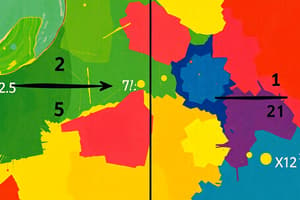Podcast
Questions and Answers
Subtracting fractions involves cross-multiplying the numerators and placing the products over the product of their denominators.
Subtracting fractions involves cross-multiplying the numerators and placing the products over the product of their denominators.
False (B)
When dividing fractions, we swap the positions of the numerator and denominator of the second fraction.
When dividing fractions, we swap the positions of the numerator and denominator of the second fraction.
True (A)
Multiplying fractions involves adding the numerators and denominators together.
Multiplying fractions involves adding the numerators and denominators together.
False (B)
When dividing fractions, we change the slash between the two parts into a small f.
When dividing fractions, we change the slash between the two parts into a small f.
Fractions are not used to represent parts of something divided equally.
Fractions are not used to represent parts of something divided equally.
Fractions consist of a numerator and an exponent.
Fractions consist of a numerator and an exponent.
If a pizza is divided into six slices, each slice would be one tenth of the pie.
If a pizza is divided into six slices, each slice would be one tenth of the pie.
When someone asks for three quarters (¾) of the pizza, they want three out of every four pieces.
When someone asks for three quarters (¾) of the pizza, they want three out of every four pieces.
Comparing fractions involves determining whether one set of numbers can be interchanged with another without changing the value.
Comparing fractions involves determining whether one set of numbers can be interchanged with another without changing the value.
To add two fractions, it is important that the numerators are multiplied by the common denominator.
To add two fractions, it is important that the numerators are multiplied by the common denominator.
The quotient obtained after adding fractions is the result of subtracting the original fractions.
The quotient obtained after adding fractions is the result of subtracting the original fractions.
Study Notes
Fractions
Fractions are a fundamental concept of mathematics used to represent parts of a whole. They consist of two parts: a numerator, which represents how many parts you have, and a denominator, which represents what each part is called. For example, if we divide a pizza into six slices, each slice would be one sixth of the pie. Here's more information on fractions:
Parts of a Whole
Consider a pizza divided into six equal pieces, like so: ⅙ ⅙ ⅙ ⅈ ⅇ ⅆ. Each piece represents an equal fraction of the entire pizza. If someone asks for three quarters (¾) of the pizza, they mean that person wants three out of every four pieces. So while there may only be six pieces, those six pieces make up the entire pizza, giving a value of 6 as the denominator.
Comparing Fractions
Comparing fractions involves determining whether one set of numbers can be interchanged with another without changing the value. For instance, 3/8 can be compared to 9/24 because both sets of numbers show the same amount. In this case, 9/24 = 3/8 because 9 parts out of 24 means the same thing as 3 parts out of 8.
Adding Fractions
The process of adding fractions requires that the denominator remains the same, which means that the denominators must be equivalent. To add two fractions, multiply both numerators by the common denominator and then add them together. Afterward, divide the result by the common denominator. The quotient obtained will be the sum of the original fractions added together.
Subtracting Fractions
Subtracting fractions works similarly to adding fractions, except with opposite signs. As long as the denominators are equal, we can subtract the numerators directly, keeping the common denominator.
Multiplying Fractions
Multiplying fractions involves cross-multiplying the numerators and placing the products over the product of their denominators:
⅔ × ½ = ¾ × ¼ = ⅞
Dividing Fractions
When dividing fractions, swap the positions of the numerator and denominator of the second fraction and write the larger division above the smaller one. Then, change the slash between the two parts into a small f and flip the division sign:
½ ÷ ⅛ = ½ / ⅛ = ⅝
Fractions are an essential part of mathematics, used to represent parts of something divided equally. They provide valuable knowledge about how to share things fairly, making them applicable in various aspects of life.
Studying That Suits You
Use AI to generate personalized quizzes and flashcards to suit your learning preferences.
Description
Learn the fundamental concept of fractions, including the parts of a whole, comparing fractions, adding, subtracting, multiplying, and dividing fractions. Fractions are vital in representing parts of a whole and are used in various real-life scenarios.




